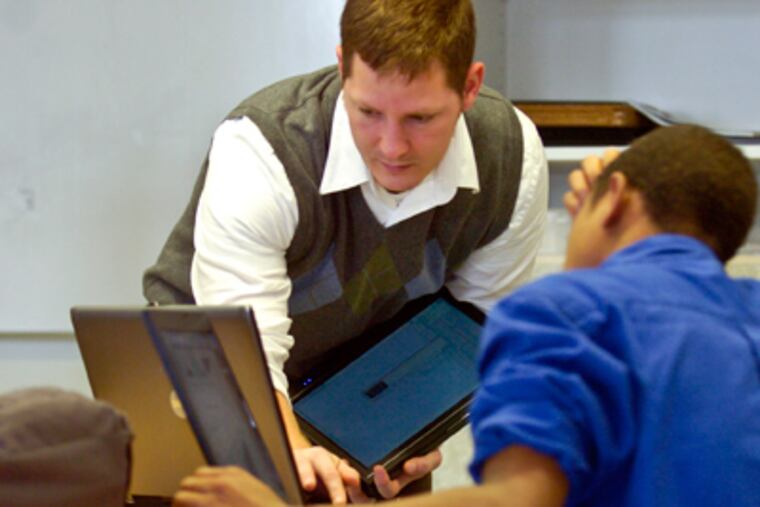Philadelphia teacher's methods make math add up
No textbooks, no paper, no chalk, no desks, and no assigned seats. Instead, students in Thomas Gaffey's ninth-grade algebra class at Philadelphia's High School of the Future use laptops while sitting in rolling chairs at trapezoidal tables spaced out in hexagonal classrooms.

No textbooks, no paper, no chalk, no desks, and no assigned seats.
Instead, students in Thomas Gaffey's ninth-grade algebra class at Philadelphia's High School of the Future use laptops while sitting in rolling chairs at trapezoidal tables spaced out in hexagonal classrooms.
And Gaffey, 28, encourages his students to find answers to their own questions.
"Is this an obtuse triangle?" one student asks.
"Well, what can you tell me about an obtuse triangle?" Gaffey replies.
"One of the angles has to be more than 90 degrees," the student answers.
"Are any of the angles here like that?"
"Yeah. Oh, I get it now!"
This snippet of student-driven discussion is a glimpse of the style and approach that have earned Gaffey national and international recognition. He placed second in Microsoft's U.S. Innovative Education Forum in August, then represented the United States at the Worldwide Innovative Education Forum in South Africa and was named a semifinalist.
Les Foltos, one of the judges who reviewed Gaffey's work, was impressed by his emphasis on "actively engaging students in solving real-world problems."
In his classroom on a recent Tuesday, Gaffey's challenge to his "learners" - as students in the Parkside public school are called - was to estimate Earth's land area.
To solve the problem, the class first covered basic concepts about area and polygons - shapes with three or more straight sides.
Gaffey then asked, "If a shape has four sides, is it always a polygon?"
Learners who answered yes (the wrong answer) were asked to redefine what a polygon is, while those who answered no were asked to draw a four-sided shape that was not a polygon on the class "smart board."
Gaffey drew a shape with three straight sides and one curved side.
"Is this a polygon?" he asked.
"No," the class responded.
"I'm not teaching polygons," Gaffey later explained. "I'm teaching a process."
So, how to attack the land area of Earth?
The class drew lines through each of the continents, chopping them up into complex polygons, then simple polygons.
The final phase was to derive formulas for the areas of the simple polygons, and add up the areas.
Geometry, algebra, and estimation are the three fixtures of Gaffey's Project 100 course, created two years ago as an elective that supplements the core Algebra 1 class for ninth graders.
Brian Cohen teaches Algebra 1 parallel with Gaffey's class. They collaborate to address weaknesses in students in this school, where over the last two years fewer than 15 percent of 11th graders were proficient in math, according to state tests.
"Math education, more than any other subject, is in need of drastic reform," Gaffey said. "Mathematics is a tool that we use, and that fact is almost nonexistent in traditional math education."
Colleagues said they considered Gaffey a prime example of the school's mission of progressive learning.
"His approach allows the learners to develop a sense of self-sufficiency in learning, using the tools at their disposal to understand a concept," Cohen said. "It's pretty awesome."
Students who took his class last year credit Gaffey with creating a math class that is fun, educational, and effective.
"There's never a boring day with him," sophomore Tysheka Spencer said. "Students want to do something that they're interested in and hope to remember later on in life."
"I went into the class thinking that I would fail and walked out with a new sense of accomplishment," Bria Lawrence said.
"Project 100 is never a class I dread to go to," Brandi Wells said. "It's a class that most learners believe is a step above a regular math class."
Current student Christian Gimeno said Gaffey "has a different perspective of what math is and how it should be taught. I enjoy his method, because he really challenges you. It's not just meaningless equations."
Gaffey hopes the class serves as a model for math education.
"If we want to teach math to learners, we should teach math how it is actually used," he said. "It doesn't matter how much you know. It matters what you can do."